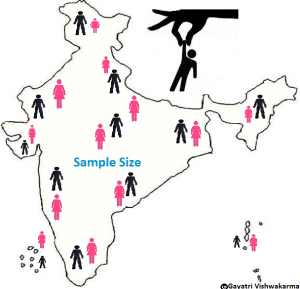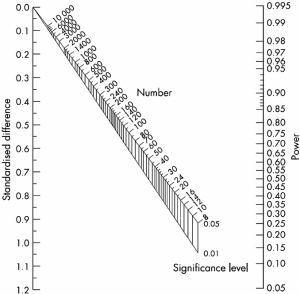 The sample size is called a sample as it represents part of the study group (or study population) whose responses to treatment, opinions and behaviour we care about in medical research. Sample size plays an important role at two stages of a study i.e. at the planning stage and at the interpretation stage.
The sample size is called a sample as it represents part of the study group (or study population) whose responses to treatment, opinions and behaviour we care about in medical research. Sample size plays an important role at two stages of a study i.e. at the planning stage and at the interpretation stage.
Good amount of researcher community believes in a myth that “Larger sample size is better”. If it is true then how large it should be? Can we analyze data approaching infinity? Then why we are talking about sample size; whatever sample you get to analyze it. What is the science behind it? The sample size is just like a light bulb. If it is fed beyond its capacity, it will explode and if it is fed less than its capacity it will not give you enough light.
Usually, having more information is a good thing for a researcher however if your data is extremely large, it may create some potential issues. Similarly, if your data is small, it will not represent the study population and you may not be able to infer about it. For example, a prevalence of 10% of sample size 20 would have a 95% confidence interval (CI) of (1, 35), which is not very precise or informative. On the other hand, a prevalence of 10% of sample size 400 would have a 95% CI of (7, 13) which may be considered sufficiently accurate because of a narrow confidence interval. Hence, having an optimum sample size for a study is mandatory to ensure that estimates for an outcome are obtained with required precision and confidence. There are three main reasons for calculating optimum sample size i.e. Ethical, Scientific and Economic.
Another challenge in sample size is its calculation. The question “How many subjects do I need for my study?” is similar to a question “how much money will you spend in this summer vacation?”. It requires some information such that where you want to go (outside the town or stay at); where you want to stay (tent or five-star hotel); for how long (days); you want to go with family or friends etc. Likewise, you have to gather some information to calculate sample size. It depends on the research question, study outcome and study design, however lot of other information is also required which may be assumed according to research budget. The margin of error, design effect, effect size, level of significance, power and p-value may be the scary terms for a young researcher. To avoid confusion, it is suggested to consult a statistician.

PLEASE AVOID use of the following statements instead GIVE proper justification for sample size:
- “There is no prior information available on the present subject/research question“
When prior information is not available, small study/pilot study may be conducted to get this information. 20 – 50 subjects can be taken according to budget and feasibility of the study.
- “Sample size from similar type of the previous study shows statistically significant results consequently same sample size would be sufficient for the present study”
Study population may be different so you may use same approximations such as level of significance, power, and effect size; however, you have to use proportion/standard deviation of your study population.
- “On an average, 50 patients get registered per year in this clinic, of whom 10% may not give consent to take part in the study. Hence, the sample size of 90 patients will be sufficient over the period of two-years of the study“
Sample size should not be decided on the number of available patients alone as balancing feasibility and power of the study is equally important. It is recommended to conduct a multi-centric study in case of a small number of patients at one centre to provide sufficient power to identify a clinically important difference. However, if you are conducting a study on patient’s satisfaction or quality of life and their regular care, sample size might not be as important because valuable information from individual patients will be recorded about their requirements and experiences.
You May Also Like The Following Articles:
Last modified: 21/11/2019







